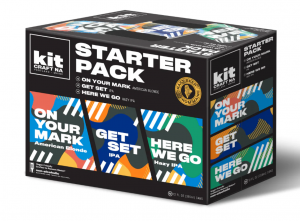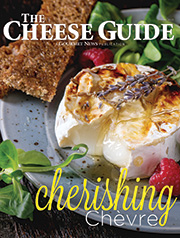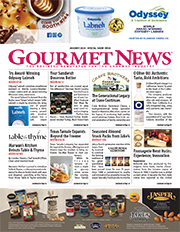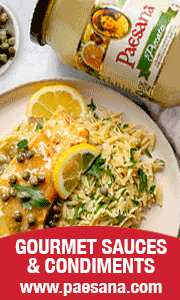Steeped Offers Alternative as Compostable Gourmet Coffee Bags
 Steeped Coffee, a Certified B Corp, is celebrating National Gourmet Coffee Day this Jan. 18 with a non-traditional ask for gourmet coffee lovers: reduce your coffee waste. Steeped is leading a movement to reduce the world’s dependence on non-recyclable, single-serve coffee pods, and has pioneered a revolutionary single-serve brewing method that preserves the full flavor of gourmet coffee while being fully compostable and requiring no brewing machinery.
Steeped Coffee, a Certified B Corp, is celebrating National Gourmet Coffee Day this Jan. 18 with a non-traditional ask for gourmet coffee lovers: reduce your coffee waste. Steeped is leading a movement to reduce the world’s dependence on non-recyclable, single-serve coffee pods, and has pioneered a revolutionary single-serve brewing method that preserves the full flavor of gourmet coffee while being fully compostable and requiring no brewing machinery.
More than 10 billion single-serve coffee pods end up in landfills each year. The number of pods consumed since 2009 could wrap around the planet more than 500 times. With a process brewed similar to tea, Steeped is helping to make quality coffee from hundreds of top brands accessible and sustainable. Steeped Packs contain craft-roasted, freshly ground pre-portioned coffee that is triple nitro-sealed to guarantee each perfect, “barista-approved” cup. The company’s Guilt-Free Packing is commercially compostable, from the outer packaging to the inner Steeped Brew Bags.
“At Steeped, we are changing the way people view single-serve coffee, delivering all of the benefits with none of the barriers,” said Josh Wilbur, founder and CEO. “We are proud to help drive a global movement to reduce our impact on the planet.”
Steeped was honored in 2023, making the 2023 Inc. Magazine’s Best in Business list, USA Today’s 10Best List and Good Housekeeping’s list of top coffee makers. More than 500 top roasters across the country now use the company’s revolutionary Steeped Brewing Method. Steeped Packs are available for purchase online, at grocery stores or through hospitality, office and other wholesale providers.
“Steeped doesn’t take its barista-approved standards lightly and we’ve worked closely with industry leading experts to validate every aspect of the Steeped Method from freshness, quality, extraction, shelf life, and most importantly, consistent taste to bring the most authentic specialty experience directly to single-serve coffee lovers,” Wilbur said. “We are proud of the incredible partnerships we’ve forged with the industry’s top specialty coffee roasters, including names like Counter Culture, Addictive and Cat and Cloud.”
Steeped Coffee features include:
● 100 percent specialty coffee: quality coffee ethically sourced directly from farmers
● Steeped Brew Bag: non-GMO filters that regulate ideal water-in and maximum flavor-out
● Guilt-free packaging: made using plant-based renewable and compostable materials
● Nitro sealed: removes oxygen, stopping the clock on freshly ground beans
● Pre-portioned single-serve: only brew what you use, reducing wasteful consumption
● Precision ground: consistent water-cooled grinding to the micron
● Just add water: single-serve convenience with no machines required
● Barista approved: tested by multiple independent specialty coffee Q-graders for freshness, quality, and taste
Steeped, Inc. based in San Francisco, is a Certified B Corp and Benefit Corporation focused on every detail from farm-to-cup and beyond, to bring people the most convenient, quality, ethically sourced, and sustainably packaged products available. Steeped is the new standard in coffee helping to make quality coffee more accessible through its proprietary technology and Steeped Brewing Method that is licensed to over 500 of the top specialty roasters around the globe. Steeped delivers 100 percent freshly roasted, precision ground, and nitro-sealed specialty coffee pre-portioned within Steeped Brew Bags. Steeped Coffee is the simplest way to make a perfect cup of coffee by just adding water, with no machine needed. Welcome to Coffee Simplified.
For more news of interest to the specialty beverage industry, subscribe to Gourmet News.
Kit NA Brewing Launches Starter Pack for Dry January
 Kit NA Brewing, a non-alcoholic beer company celebrating inclusivity and connection, is working this season to assist resolutioners and Dry January participants to get their proverbial “K*t” together. Now through January, with a unique and inspirational Dry January experience that breaks away from the traditional, Kit NA Brewing redefines Dry January and makes it a month of holistic well being, fun, and charity with a limited edition “Kit,” available at kitna.beer.
Kit NA Brewing, a non-alcoholic beer company celebrating inclusivity and connection, is working this season to assist resolutioners and Dry January participants to get their proverbial “K*t” together. Now through January, with a unique and inspirational Dry January experience that breaks away from the traditional, Kit NA Brewing redefines Dry January and makes it a month of holistic well being, fun, and charity with a limited edition “Kit,” available at kitna.beer.
While many embark on Dry January to detox and rejuvenate, Kit NA Brewing is taking it up a notch with a special package that’s bound to get everyone excited. Dubbed the “K*t”, this exclusive Dry January offer is available to consumers who donate through the brand’s website throughout the month of January and while supplies last. All proceeds will go to Kit NA’s mental health organization partner, Sound Mind Live, fostering awareness, conversation and community around mental health through the power of music.
“While Get Your K*T Together is all about being yourself, Kit NA Brewing is also committed to educating the masses about the non-alcoholic fun to be had,” said Will Fisher, co-founder of Kit NA Brewing. “Throughout December and January, we’ll have Kits that help make the Dry January experience one to celebrate and remember, all the while giving back to an important cause and raising awareness for mental health.”
Get Your “K*t” Together is not just a slogan; it’s a movement. Kit NA Brewing encourages everyone, whether you’re a seasoned Dry January participant or new to the concept, to join this revolution of self-improvement and make a difference. Enjoy great non-alcoholic beer, inspire yourself with motivational messages, and support a worthy cause. Get Your K*t Together with Kit NA Brewing this Dry January! For more information, please visit https://www.kitna.beer/.
Kit NA Brewing, founded in 2021 by co-founders Rob Barrett and Fisher, is a non-alcoholic brewery that enables consumers to have a beer that is true to them. Their dedication to creating exceptional NA beer has earned them worldwide recognition and numerous awards. Kit NA Brewing’s mission is to provide high-quality craft beer without the buzz, allowing individuals to enjoy a true craft beer experience without compromise.
For more news of interest to the food and beverage industry, subscribe to Gourmet News.
Keke Palmer Promotes HelloFresh Convenience, Nutrition
 HelloFresh, the world’s leading meal kit company, announced a partnership with award winning actress, musical artist and producer Keke Palmer. The new campaign spotlights the delicious possibilities created when cooking with HelloFresh, especially as consumers embrace healthier habits in the New Year.
HelloFresh, the world’s leading meal kit company, announced a partnership with award winning actress, musical artist and producer Keke Palmer. The new campaign spotlights the delicious possibilities created when cooking with HelloFresh, especially as consumers embrace healthier habits in the New Year.
“As a busy working mom, I know first-hand how tough it can be to find the time to maintain healthy eating habits. But HelloFresh has made it easy to plan and cook delicious, guilt-free meals you can make in a snap,” said Palmer.
Keke stars in a series of HelloFresh ads in which she reminds viewers that eating well doesn’t mean sacrificing delicious flavor when cooking with HelloFresh. For each spot, Keke pops up in unexpected places to swap a bland chicken dish or lackluster takeout order with a tasty HelloFresh dish. Consumers can see the campaign across TV, radio, streaming video, social media, OOH and more.
“We’re thrilled to partner with Keke for this new campaign. Her hilarious charm and spontaneity really shines through as she reminds consumers that eating well can be an easy, exciting and enjoyable experience with HelloFresh,” said Marcus von Franck, chief marketing officer at HelloFresh North America. “As we all look to embrace healthier habits in the New Year, our customers can count on HelloFresh to provide them with delicious and guilt-free recipes.”
As the world’s leading meal kit company, HelloFresh makes eating well fun. By delivering fresh ingredients and easy-to-follow recipes right to your doorstep, HelloFresh takes the stress out of healthier eating habits and makes meal planning and cooking an enjoyable experience. HelloFresh offers more than 40 weekly recipes and 100+ seasonal and convenience items so all of mealtime needs are covered–from breakfast and appetizers to dinner and desserts.
For more information, visit www.hellofresh.com.
HelloFresh is the world’s leading meal-kit company. Founded in Berlin in November 2011, the company operates across 18 international markets. In 2022, HelloFresh furthered its mission to “change the way people eat forever” by delivering more than 490 million meals to customers across the United States. HelloFresh was voted the Most Trusted Meal Kit Delivery Service in America in 2021 and 2022 by Newsweek. HelloFresh has offices in New York, Chicago and Boulder.
For more news of interest to the specialty food industry, subscribe to Gourmet News.








